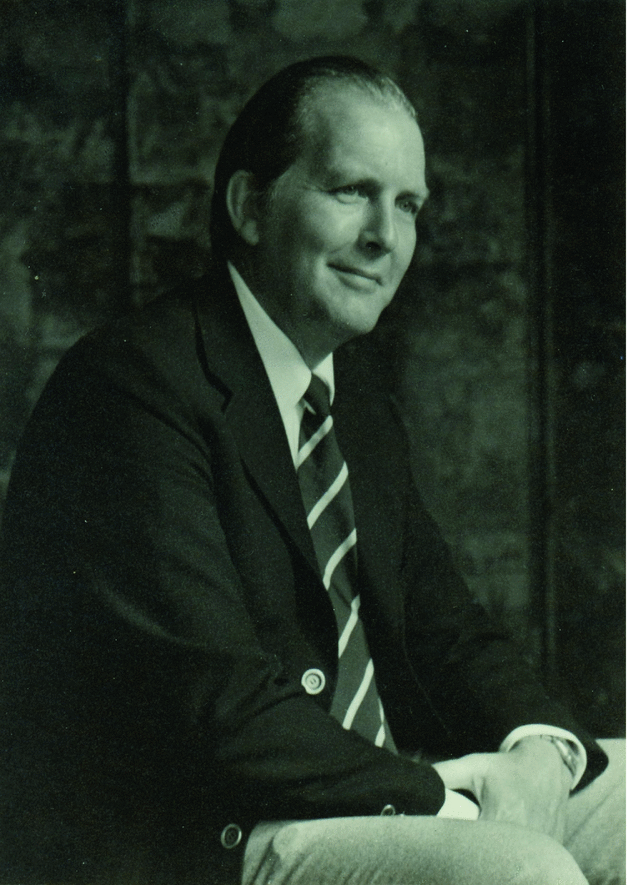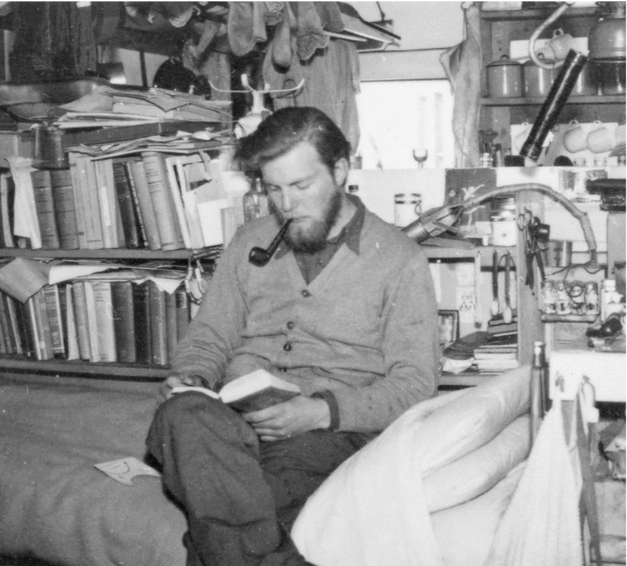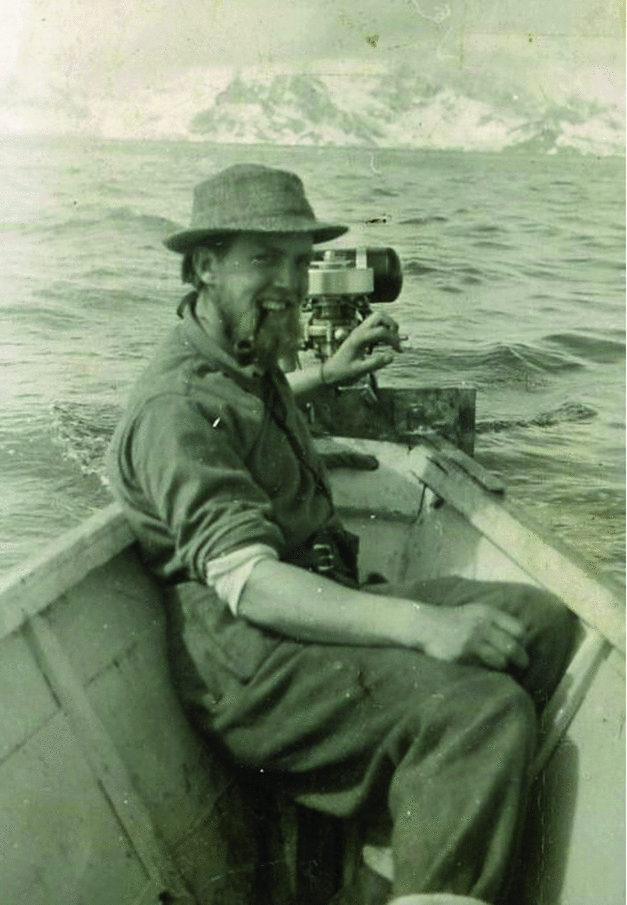Richard Maitland Laws (Fig. 1) died on 7 October 2014. Usually known as known as Dick Laws, his career spanned the world. From his Northumbrian upbringing his career as a zoologist took him via Cambridge University to the Southern Ocean, the cold of Antarctica, the heat of Africa, the Directorship of the British Antarctic Survey and the Mastership of a Cambridge College.

Fig 1. Portrait of Dick Laws.
Dick Laws was born in Northumberland on 23 April 1926, educated at Dame Allan's School, Newcastle-upon-Tyne and gained a scholarship to St Catherine's College Cambridge. He graduated with a first class degree in zoology in 1947. His early career (1947–1953) was with the Falkland Islands Dependencies Survey (FIDS) studying the biology and ecology of the Southern Elephant Seal and spending two years (1948–1950) at Signy Island in the South Orkneys, where he was also Base Leader and also at South Georgia (Figs. 2, 3). His detailed research on the seals resulted in the publication of four major papers including one on their growth and age which utilised, for the first time in mammals, the relationship between concentric rings found in cross sections of their teeth and their age. He was awarded a Cambridge doctorate for this research in 1953. Fascinated by large mammals he transferred his interest to whales, first as a biologist and whaling inspector on the factory ship F/F Balaena in the Antarctic and then as Principal Scientific Officer at the National Institute of Oceanography (1953–1961). He then moved to East Africa to study the ecology of elephant and hippopotamus as fundamental to the management of their populations and their conservation. Dick Laws was the first Director of the Nuffield Unit of Tropical Animal Ecology based in the, then, Queen Elizabeth National Park, Uganda 1961–1967, followed by a year in Kenya heading the Tsavo Research Project. He resigned from the latter Project as his proposal to cull the elephant population to protect its habitat was not accepted by the authorities (subsequently large numbers of elephants died in drought conditions as their habitats could not support them). Returning to Cambridge he was awarded a Smuts Memorial Fellowship and a Leverhulme Fellowship to continue research.

Fig 2. Dick Laws in Clifford House, Signy Island, 3 February 1949, photograph by Charles Skilling (supplied by the British Antarctic Survey Archives Service. Archive ref. AD6/19/2/H138).

Fig 3. Dick Laws at South Georgia.
His appointment to the British Antarctic Survey (BAS) as Head of the Life Sciences Division in 1969 was a turning point in his career and came at a critical time for the Institute. The organisation was in transition from mainly field-based survey work to more experimental scientific research in all areas: atmospheric, geological, glaciological and biological. When he succeeded Sir Vivian (Bunny) Fuchs as its Director in 1973, Dick progressed this development throughout his 14 years at BAS. The Survey became part of the Natural Environment Research Council (NERC) in 1967.
Dick Laws co-ordinated the centralisation of the Institute in Cambridge during 1973–1974 from its outposts in London, Slough, Huntingdon, Birmingham and Edinburgh. The organisation endured a difficult period during the late1970s and early 1980s with a declining budget. He took the organisation from a financial low point to a relatively healthy position with expanded finances, staff and facilities in 1987. As Director BAS, Dick was a crucial conduit for the UK Government in the early days of the South Atlantic conflict in 1982 for information on Argentine activities, not only around South Georgia, but also during the initial stages of the invasion of the Falkland Islands. During the hostilities on South Georgia, Dick ensured the safety of BAS staff on the island by reinforcing field parties with personnel from the main BAS base, which was characteristic of his concern for the well being of all his staff. Following the retaking of the Falklands in June 1982 the then Prime Minister, Margaret Thatcher, decided to strengthen the UK's presence in that part of the world by substantially increasing BAS's budget to develop its scientific research programme. Over the next six years or so, Dick directed an intensive building programme which included a replacement ice-strengthened ship, an extension to the HQ in Cambridge, the replacement of a hitherto sub-surface Antarctic station (Halley) on the Brunt Ice Shelf by buildings on steel platforms, the construction of a hard runway at Rothera on the Antarctic Peninsula with extensive support facilities and the purchase of additional aircraft to enhance field operations, together with the introduction of satellite communications and the recruitment of further scientific and support staff. During this time BAS scientists discovered the ozone hole over Antarctica, which led to the phasing out of the use of chloroflourocarbons. Dick stated that it was ‘an extremely important finding that more than justified the whole expenditure on our science programmes’.
Throughout his directorship he vigorously advocated all aspects of Antarctic science within the NERC and in skilful negotiations with the UK Government, the Foreign Office, Universities and internationally within the Antarctic Treaty System. He was also Director of the NERC Sea Mammals Research Unit, latterly based in Cambridge. During his Directorship of BAS he was the most influential figure in determining the direction of British scientific policy in the Antarctic. On his retirement from BAS a fund was established for the Laws Prize to be awarded annually in recognition of the achievements of outstanding young scientists in the Survey. This was a reflection of his unstinting support for young early-career scientists throughout his professional life.
Dick took a keen interest in University affairs in Cambridge and was appointed Master of St Edmund's College in 1985, a post he held for 11 years. He served on the Financial Board, the Council of Senate and the Local Examinations Syndicate. Here again, he progressed the development of his College and established it as a significant player in Cambridge University.
His contribution to the management and organisation of polar science was immense. He played a major role in international Antarctic affairs. Dick was a prime mover in SCAR (Scientific Committee on Antarctic Research) being a member of the Group of Specialists on Seals (1972–1998), where he was humorously known as ‘The Alpha Male’. He chaired the SCAR Working Group on Biology for 6 years, he was a member of the Working Group on Logistics and the BIOMASS (Biological Investigations of Marine Antarctic Systems and Stocks) Executive. He was elected President of SCAR (1990–94) and continued as a member of the SCAR executive until 1998. To all the international activities of SCAR Dick brought expert knowledge, wisdom and forethought on a wide range of issues. In the UN Food and Agricultural Organisation he served on the Marine Mammals Working Party and chaired the Scientific Consultation on Conservation and Management of Marine Mammals and their Environment in 1976.
The creation of the BIOMASS programme by SCAR in 1976 was a milestone in Antarctic marine biology. Dick Laws's clear vision contributed hugely to the development of this international programme. He also created the acronym and designed its logo. BIOMASS investigated the living resources of the Southern Ocean and it ensured that an ecosystem approach was adopted to integrate the many and varied component studies. From this sprang international negotiations (Dick was influential as an advisor to the Foreign and Commonwealth Office at this time) resulting in the Convention for the Conservation of Antarctic Marine Living Resources (CCAMLR) in 1980. Throughout this process Dick Laws showed his considerable mediation skills and diplomacy. The result was a successful international system to monitor and regulate the exploitation of fish and squid stocks in the Southern Ocean around Antarctica.
There is no doubt that Dick Laws had a major world-wide influence on research into large mammals. His pioneer work on the ageing of individual animals using growth rings in their teeth has formed a key element in their population studies. Starting with his research on the Southern Elephant Seal at Signy Island and South Georgia, the baleen whales in the South Atlantic and extended to the large game animals of East Africa this work has formed the basis for the conservation and controlled exploitation of these important and unique animal populations. He rigorously highlighted the need for rational management strategies to underpin such approaches. It seems unlikely that an individual scientist will ever again exert such a dominant influence across such a broad spectrum of research.
Dick Laws published numerous scientific papers, books and review articles. His autobiography lists a total of 259 publications (Part III on Scott Polar Research Institute web site, edited by A S Blix). His nine books, as author or joint editor, ranged from the very readable Elephants and their habitats (with I S C Parker and R C B Johnstone, 1975) through Antarctic nutrient cycles and food webs (with W R Siegfried and P R Condy, 1985) and Life at low temperatures (with F. Franks, 1990) to Elephant seals:population ecology, behaviour and physiology (with B J Le Boeuf, 1994).
Dick Laws was awarded the degrees of MA, PhD, ScD (Cantab) and Honorary DSc (University of Bath) and elected a Fellow of the Zoological Society of London from 1960 and a Fellow of the Institute of Biology from 1973. He was elected a Fellow of the Royal Society in 1980 and served as Chair of the Interdisciplinary Scientific Committee on Antarctic Research (1988–1993). He was honoured with the award of the Bruce Memorial Medal of the Royal Society of Edinburgh in 1954 for his Antarctic research, the Scientific Medal of the Zoological Society of London (1966), the Polar Medal (1976 and second clasp 2001), elected Foreign Member of the Norwegian Academy of Science and Letters (1998) and Honorary Fellow of St Catherine's College and St Edmund's College, Cambridge. In 1983 he was appointed Commander of the British Empire.
Art, like music, forms a perfect complement to human experience and the maker may not wish his efforts to be widely seen by others. Few knew that Dick had considerable creative talents expressed as an accomplished artist working mainly in water colours and he enjoyed painting landscapes, plants, animals and birds. He had little art training but was greatly influenced by the work of Edward Wilson. Dick began his Antarctic drawing and painting on his long voyage south to Antarctica on John Biscoe in 1947. On Signy Island he made rapid sketches in the field with shorthand colour notes, which were worked up during the winter period (when the seals had gone!) into fine watercolours – his medium of choice for polar subjects. His paintings of the base, Clifford House, at Signy and elephant seals on the beach in Moraine Fjord at South Georgia are truly exquisite. As he wrote later ‘Undoubtedly the most satisfying period of my artistic life was during my first years in the Antarctic, at Signy Island.’ Dick was elected a member of the Society of Wildlife Artists in 1963 (Fig. 4).

Figs 4. Water colour painting by Dick Laws showing Base H, Signy Island.
Dick Laws was well known to friends and colleagues throughout the world as a scientist who consistently maintained the highest standards and as an administrator and manager who was never prepared to compromise his principles. At BAS he was always approachable and found time to speak with even the most junior of his staff. In the field he was a most agreeable companion – diligent, painstaking and quietly humorous. Dick has left many legacies through his long and varied career and he will be sorely missed by many people in the polar world, in scientific and collegiate life, as well as his family and many friends. His quick smile, his kindness, his friendly support in times of need, his storytelling and his sense of humour will be remembered by many. He died on 7 October 2014 after a major stroke and is survived by his wife Maureen (they met on a ship when he was returning from the Antarctic to the UK after she and her parents had boarded in Lisbon; they married in 1954) and their three sons: Richard, Christopher and Andrew to whom we extend our deepest condolences.






